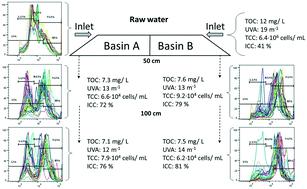当前位置:
X-MOL 学术
›
Environ. Sci.: Water Res. Technol.
›
论文详情
Our official English website, www.x-mol.net, welcomes your
feedback! (Note: you will need to create a separate account there.)
Water quality changes during the first meter of managed aquifer recharge
Environmental Science: Water Research & Technology ( IF 3.5 ) Pub Date : 2021-2-12 , DOI: 10.1039/d0ew00839g Kristofer Hägg 1, 2, 3, 4, 5 , Jing Li 1, 2, 3, 4, 5 , Masoumeh Heibati 5, 6, 7, 8, 9 , Kathleen R. Murphy 5, 6, 7, 8, 9 , Catherine J. Paul 1, 2, 3, 4, 5 , Kenneth M. Persson 1, 2, 3, 4, 5
Environmental Science: Water Research & Technology ( IF 3.5 ) Pub Date : 2021-2-12 , DOI: 10.1039/d0ew00839g Kristofer Hägg 1, 2, 3, 4, 5 , Jing Li 1, 2, 3, 4, 5 , Masoumeh Heibati 5, 6, 7, 8, 9 , Kathleen R. Murphy 5, 6, 7, 8, 9 , Catherine J. Paul 1, 2, 3, 4, 5 , Kenneth M. Persson 1, 2, 3, 4, 5
Affiliation

|
The capacity of an artificial recharge field to alter organic matter and the bacterial flora of surface water was assessed by following changes in bacterial communities and composition of natural organic matter (NOM) over the first meter of infiltration depth. The sampling strategy applied in this study ensured that water samples consisted only of infiltrated water, excluding natural groundwater. Water was sampled at 50 and 100 cm below the surface of an infiltration basin divided into two halves; one side was dried and frozen and one was infiltrating water during the winter period prior to the sampling period. Bacterial cell counts, proportions of intact cells and community fingerprints were determined by flow cytometry, and NOM was characterized using total organic carbon (TOC), UV254 nm-absorbance (UVA) and fluorescence spectroscopy. Around 40% of the NOM was removed after only 50 cm. Protein-like components were reduced to a larger extent (45–50%) than the humic-like components (25%), suggesting removal of mostly biodegradable fractions of NOM. After only 50 cm of infiltration, about 99% total cell count (TCC) was removed. The flow cytometric data revealed that the bacterial communities collected after infiltration from the basin area that had been dried and frozen were more similar to those in the raw water. This suggests that drying and freezing the basin negatively impacted its treatment capacity. The results from this study highlight the importance of a well-developed biofilm and unsaturated zone for artificial recharge.
中文翻译:

在管理的含水层第一米补给过程中水质变化
人工补给场改变地表水中有机物和细菌菌群的能力是通过在第一渗透深度内跟踪细菌群落和天然有机物(NOM)组成的变化来评估的。在这项研究中采用的采样策略可确保水样仅由渗入水组成,天然地下水除外。在一个分为两半的浸润池表面以下的50和100 cm处取样水。一侧干燥并冷冻,另一侧在采样期之前的冬季渗透水。通过流式细胞术确定细菌细胞计数,完整细胞的比例和社区指纹,并使用总有机碳(TOC),UV 254 nm表征NOM-吸光度(UVA)和荧光光谱。仅50厘米后,约40%的NOM被去除。与腐殖质样组分(25%)相比,类似蛋白的组分减少程度更大(45–50%),这表明去除了大部分可生物降解的NOM。仅渗透50厘米后,去除了约99%的总细胞数(TCC)。流式细胞仪数据显示,渗透后从干燥和冷冻的流域区域收集的细菌群落与原水中的细菌群落更为相似。这表明盆地的干燥和冷冻对其处理能力有负面影响。这项研究的结果凸显了发达的生物膜和不饱和区对于人工补给的重要性。
更新日期:2021-02-17
中文翻译:

在管理的含水层第一米补给过程中水质变化
人工补给场改变地表水中有机物和细菌菌群的能力是通过在第一渗透深度内跟踪细菌群落和天然有机物(NOM)组成的变化来评估的。在这项研究中采用的采样策略可确保水样仅由渗入水组成,天然地下水除外。在一个分为两半的浸润池表面以下的50和100 cm处取样水。一侧干燥并冷冻,另一侧在采样期之前的冬季渗透水。通过流式细胞术确定细菌细胞计数,完整细胞的比例和社区指纹,并使用总有机碳(TOC),UV 254 nm表征NOM-吸光度(UVA)和荧光光谱。仅50厘米后,约40%的NOM被去除。与腐殖质样组分(25%)相比,类似蛋白的组分减少程度更大(45–50%),这表明去除了大部分可生物降解的NOM。仅渗透50厘米后,去除了约99%的总细胞数(TCC)。流式细胞仪数据显示,渗透后从干燥和冷冻的流域区域收集的细菌群落与原水中的细菌群落更为相似。这表明盆地的干燥和冷冻对其处理能力有负面影响。这项研究的结果凸显了发达的生物膜和不饱和区对于人工补给的重要性。











































 京公网安备 11010802027423号
京公网安备 11010802027423号